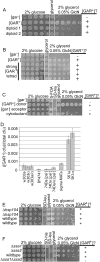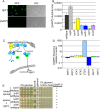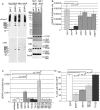A heritable switch in carbon source utilization driven by an unusual yeast prion
- PMID: 19797769
- PMCID: PMC2758746
- DOI: 10.1101/gad.1839109
A heritable switch in carbon source utilization driven by an unusual yeast prion
Abstract
Several well-characterized fungal proteins act as prions, proteins capable of multiple conformations, each with different activities, at least one of which is self-propagating. Through such self-propagating changes in function, yeast prions act as protein-based elements of phenotypic inheritance. We report a prion that makes cells resistant to the glucose-associated repression of alternative carbon sources, [GAR(+)] (for "resistant to glucose-associated repression," with capital letters indicating dominance and brackets indicating its non-Mendelian character). [GAR(+)] appears spontaneously at a high rate and is transmissible by non-Mendelian, cytoplasmic inheritance. Several lines of evidence suggest that the prion state involves a complex between a small fraction of the cellular complement of Pma1, the major plasma membrane proton pump, and Std1, a much lower-abundance protein that participates in glucose signaling. The Pma1 proteins from closely related Saccharomyces species are also associated with the appearance of [GAR(+)]. This allowed us to confirm the relationship between Pma1, Std1, and [GAR(+)] by establishing that these proteins can create a transmission barrier for prion propagation and induction in Saccharomyces cerevisiae. The fact that yeast cells employ a prion-based mechanism for heritably switching between distinct carbon source utilization strategies, and employ the plasma membrane proton pump to do so, expands the biological framework in which self-propagating protein-based elements of inheritance operate.
Figures






Similar articles
-
Prions affect the appearance of other prions: the story of [PIN(+)].Cell. 2001 Jul 27;106(2):171-82. doi: 10.1016/s0092-8674(01)00427-5. Cell. 2001. PMID: 11511345
-
A common bacterial metabolite elicits prion-based bypass of glucose repression.Elife. 2016 Nov 29;5:e17978. doi: 10.7554/eLife.17978. Elife. 2016. PMID: 27906649 Free PMC article.
-
Horizontal Transmission of Cytosolic Sup35 Prions by Extracellular Vesicles.mBio. 2016 Jul 12;7(4):e00915-16. doi: 10.1128/mBio.00915-16. mBio. 2016. PMID: 27406566 Free PMC article.
-
Glucose repression in Saccharomyces cerevisiae.FEMS Yeast Res. 2015 Sep;15(6):fov068. doi: 10.1093/femsyr/fov068. Epub 2015 Jul 22. FEMS Yeast Res. 2015. PMID: 26205245 Free PMC article. Review.
-
Amyloid formation of a yeast prion determinant.J Mol Neurosci. 2004;23(1-2):13-22. doi: 10.1385/JMN:23:1-2:013. J Mol Neurosci. 2004. PMID: 15126688 Review.
Cited by
-
Yeast prions: structure, biology, and prion-handling systems.Microbiol Mol Biol Rev. 2015 Mar;79(1):1-17. doi: 10.1128/MMBR.00041-14. Microbiol Mol Biol Rev. 2015. PMID: 25631286 Free PMC article. Review.
-
Transcriptomics Provides a Genetic Signature of Vineyard Site and Offers Insight into Vintage-Independent Inoculated Fermentation Outcomes.mSystems. 2021 Apr 13;6(2):e00033-21. doi: 10.1128/mSystems.00033-21. mSystems. 2021. PMID: 33850038 Free PMC article.
-
Construction and characterization of a Saccharomyces cerevisiae strain able to grow on glucosamine as sole carbon and nitrogen source.Sci Rep. 2018 Nov 16;8(1):16949. doi: 10.1038/s41598-018-35045-8. Sci Rep. 2018. PMID: 30446667 Free PMC article.
-
Glucose repression can be alleviated by reducing glucose phosphorylation rate in Saccharomyces cerevisiae.Sci Rep. 2018 Feb 8;8(1):2613. doi: 10.1038/s41598-018-20804-4. Sci Rep. 2018. PMID: 29422502 Free PMC article.
-
Truth in wine yeast.Microb Biotechnol. 2022 May;15(5):1339-1356. doi: 10.1111/1751-7915.13848. Epub 2021 Jun 26. Microb Biotechnol. 2022. PMID: 34173338 Free PMC article. Review.
References
Publication types
MeSH terms
Substances
Grants and funding
LinkOut - more resources
Full Text Sources
Other Literature Sources
Molecular Biology Databases
